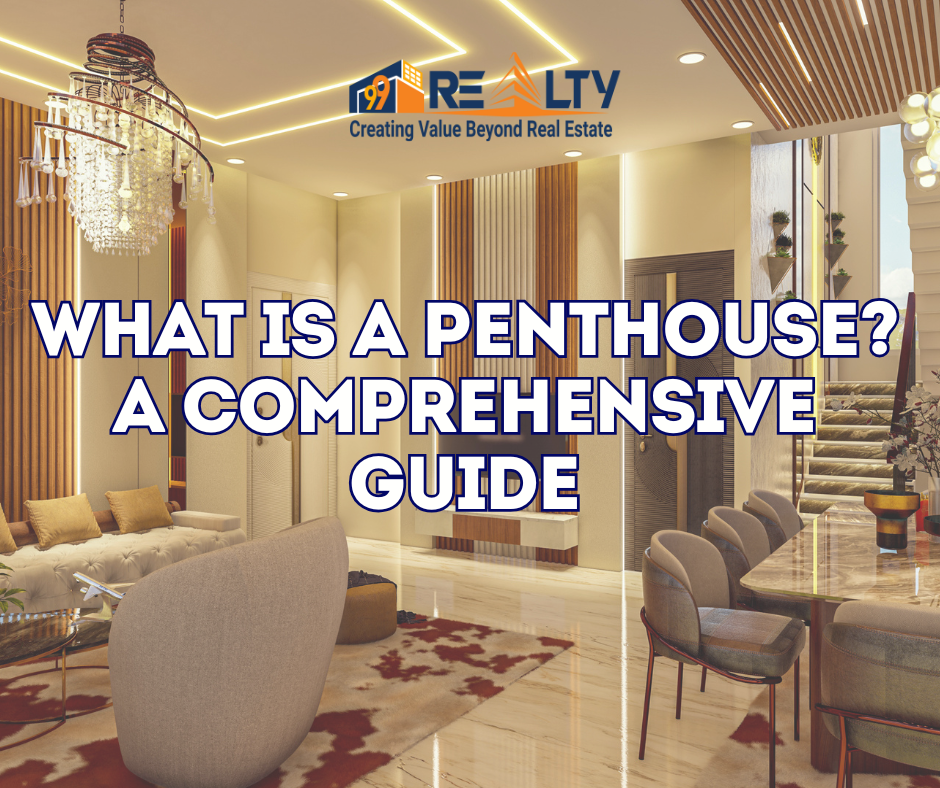In the realm of luxury real estate, the term “penthouse” signifies more than just a top-floor apartment; it embodies exclusivity, opulence, and unparalleled living experiences. This comprehensive guide delves into the essence of penthouses, their distinguishing features, advantages, potential drawbacks, and their prominence in India’s evolving real estate landscape.
Defining a Penthouse
Traditionally, a penthouse refers to a luxurious apartment situated on the highest floor of a building, offering expansive views and exclusive amenities. A penthouse is an exclusive apartment located on the top floor of a building, often characterized by expansive layouts, private terraces, and panoramic views.
These properties offer a unique blend of luxury, privacy, and status, making them highly sought after by affluent buyers. The allure of penthouses lies in their exclusivity and the premium lifestyle they offer, which includes high-end amenities and prime locations.
While originally limited to a single unit atop a structure, modern architectural designs have expanded this concept. Today, multiple penthouse units can occupy the uppermost floors, each designed to provide a unique blend of indoor luxury and outdoor leisure spaces.
Key Characteristics of Modern Penthouses
Modern penthouses are distinguished by several hallmark features:
- Expansive Layouts: These residences often boast larger floor areas compared to standard apartments, accommodating multiple bedrooms, spacious living areas, and dedicated entertainment zones.
- Private Outdoor Spaces: Many penthouses include exclusive access to terraces, balconies, or rooftop gardens, offering residents personal outdoor retreats.
- Panoramic Views: Elevated positioning provides unobstructed vistas of cityscapes, landscapes, or coastlines, enhancing the aesthetic appeal of the living space.
- Premium Amenities: High-end finishes, state-of-the-art appliances, private elevators, and advanced security systems are common in penthouse designs.
- Architectural Innovation: Unique layouts, double-height ceilings, and floor-to-ceiling windows contribute to a sense of grandeur and openness.
Types of Penthouses
- Classic Penthouse: Occupies the entire top floor of a building, providing exclusive access to outdoor spaces like terraces or balconies.
- Duplex Penthouse: Spans two levels connected by an internal staircase, allowing for distinct separation between living and private areas.
- Triplex Penthouse: Extends across three floors, offering ample space and often featuring multiple outdoor areas such as rooftop gardens or terraces.
- Bi-level Penthouse: Features two distinct levels, not necessarily connected by an internal staircase, creating unique architectural layouts and separation between different functional areas.
- Penthouse Suite: Found in hotels or resorts, these are luxurious, spacious rooms or apartments designed for short-term stays, often accompanied by exclusive services like personal butlers and room service.
- Garden Penthouse: Designed with private rooftop gardens or terraces, these penthouses offer landscaped outdoor spaces, sometimes including amenities like pools or hot tubs, providing a tranquil retreat above the city.
- Modern Penthouse: Emphasizes contemporary design elements, minimalist aesthetics, and incorporates the latest in smart home technology, often featuring open floor plans and floor-to-ceiling windows.
- Historic Penthouse: Located in older buildings, these penthouses retain the charm of historical architecture while offering modern conveniences, featuring unique elements like exposed brick, wooden beams, or arched windows.
- Luxury Penthouse: Known for opulence, these penthouses include extravagant amenities such as private elevators, wine cellars, home theaters, and top-of-the-line appliances and finishes.
- Custom Penthouse: Tailored to the owner’s specifications, these penthouses allow for a high degree of customization, which may involve merging multiple units, redesigning layouts, and selecting unique materials and finishes.
These diverse penthouse designs cater to varying preferences and lifestyles, offering a range of options for those seeking luxury living spaces.
Distinguishing Penthouses from Standard Apartments
While both penthouses and standard apartments serve as residential units, key differences include:
- Location: Penthouses are exclusively located on the top floors, whereas standard apartments can be on any level.
- Amenities: Penthouses often come with bespoke amenities not available to other residents, such as private terraces or pools.
- Design and Space: Enhanced architectural features and larger layouts are typical in penthouses, offering a more luxurious living experience.
| Aspect | Penthouse | Apartment |
|---|---|---|
| Location | Typically located on the top floor of a building, offering exclusive access to outdoor spaces and panoramic views. | Can be situated on any floor within a building, without exclusive access to outdoor areas or unique views. |
| Size and Layout | Generally more spacious with unique layouts, often including multiple levels, expansive terraces, and high ceilings. | Standardized in size and layout, primarily designed for efficient use of space without additional luxury features. |
| Amenities | Equipped with high-end appliances, private elevators, rooftop gardens, swimming pools, and other luxury features. | Offers basic amenities such as shared facilities, without exclusive or personalized features. |
| Privacy | Provides enhanced privacy due to exclusive floor occupancy and private access points. | Shared corridors and entrances with other residents, leading to less privacy. |
| Price | Commands a premium price due to exclusivity, location, size, and luxury amenities. | Generally more affordable, with prices varying based on size, location, and available facilities. |
| Maintenance Costs | Higher maintenance costs associated with larger spaces and specialized amenities. | Lower maintenance costs due to smaller size and shared facilities. |
| Customization | Offers greater scope for customization, allowing owners to tailor the space to their preferences. | Limited customization options due to standardized layouts and building regulations. |
| Views | Provides panoramic cityscape or landscape views, often unobstructed due to elevated position. | Views vary depending on the floor level and surrounding structures, often limited or obstructed. |
| Exclusivity | Represents a symbol of status and exclusivity, often limited in availability within a building or area. | More widely available, catering to a broader demographic without the exclusivity associated with penthouses. |
| Outdoor Space | Includes expansive outdoor areas such as terraces or balconies, offering private open-air environments. | Limited or no private outdoor space, with access to communal areas shared among residents. |
These distinctions highlight the unique attributes of penthouses compared to standard apartments, emphasizing the luxury, exclusivity, and enhanced living experience they offer.
Vastu Considerations for Penthouses: Incorporating Vastu principles in penthouse design can enhance harmony and positivity:
- Open Spaces: Ensure ample open areas in the east and north directions to invite positive energy.
- Structural Height: Design the south and west sides taller to align with traditional Vastu guidelines.
- Greenery: Establish gardens or place plants in the northeast corner to promote tranquility and well-being.
Advantages of Penthouse Living
Investing in a penthouse offers numerous benefits:
- Prestige and Exclusivity: Ownership signifies a high social status, reflecting success and affluence.
- Enhanced Privacy: With fewer neighboring units and restricted access, residents enjoy a secluded living environment.
- Abundant Natural Light: Elevated positioning allows for increased sunlight, creating bright and inviting interiors.
- Potential Investment Appreciation: Due to their limited availability and high demand, penthouses often experience significant value appreciation over time.
Potential Drawbacks
Despite their allure, penthouses present certain challenges:
- Premium Pricing: The exclusivity and luxury of penthouses come at a substantial cost, often significantly higher than other units in the same building.
- Increased Maintenance: Larger spaces and additional features like terraces require more upkeep, leading to higher maintenance expenses.
- Exposure to Elements: Being on the top floor can result in greater exposure to weather conditions, necessitating robust structural and insulation solutions.
- Accessibility Concerns: Dependence on elevators means that any malfunction can impact access, posing inconvenience.
Penthouses in the Indian Real Estate Market
In India, the demand for luxury housing has surged, with penthouses becoming a coveted segment. Metropolitan cities such as Mumbai, Delhi, Bengaluru, and Kolkata have witnessed a rise in penthouse developments, catering to affluent buyers seeking exclusivity and luxury.
For instance, the Palais Royale in Mumbai stands as a testament to ultra-luxurious living, featuring 72 stories and housing the world’s largest penthouse spanning 125,000 square feet across three floors. Similarly, Kolkata’s Utalika Luxury project offers penthouses with private ponds and expansive living spaces, reflecting the growing appetite for high-end residences.
Rising Demand for Luxury Housing
The luxury housing segment in India has witnessed significant growth, with sales of high-end homes increasing by 53% across seven major cities. This surge is attributed to the aspirations of the upper-middle class and high-net-worth individuals seeking premium living spaces.
Developers have responded to this demand by launching ultra-luxury projects, such as DLF’s “The Dahlias” in Gurugram, which recorded sales of 173 units totaling $1.4 billion within nine weeks.
The Surge in India’s Luxury Residential Market: An In-Depth Analysis
Market Trends and Price Appreciation
The luxury real estate market has been on an upward trajectory, with property prices in prime locations experiencing substantial appreciation. For instance, properties in Mumbai’s Malabar Hill and Pali Hill command prices upwards of ₹100,000 per square foot, while those in Gurugram’s Golf Course Road range between ₹50,000 to ₹75,000 per square foot. This price escalation reflects the limited supply of luxury properties in coveted areas, further intensifying demand.
The demand for penthouses in India’s Tier 2 and Tier 3 cities has been on the rise, reflecting a broader trend in the country’s real estate market. Traditionally, luxury housing, including penthouses, was concentrated in metropolitan areas. However, several factors have contributed to the growing interest in such properties beyond the metros.
Emergence of Tier 2 and Tier 3 Cities as Real Estate Hubs
Tier 2 and Tier 3 cities in India are rapidly emerging as significant players in the real estate sector. These cities have experienced a notable surge in the sales of properties priced between Rs 1–2 crore, with a 52% increase, totaling 132,532 apartments sold. The ultra-luxury segment, comprising properties over Rs 2 crore, saw an even sharper rise of 73%, highlighting developers’ confidence in catering to high-net-worth buyers.
Developer Strategies and Market Trends
Real estate developers are actively targeting Tier 2 and Tier 3 cities, recognizing the untapped potential in these markets. In 2024, 44% of the 3,294 acres of land acquired by developers were in these cities, indicating a strategic shift to cater to the growing demand for luxury housing.
Additionally, the luxury and ultra-luxury housing segments have emerged as key drivers of demand across 60 cities, contributing 71% of the total sales value. This trend is driven by larger ticket sizes and a balanced supply-demand dynamic in premium markets.
Factors Driving Demand for Penthouses
Several key factors contribute to the growing demand for penthouses in India:
- Economic Growth and Wealth Accumulation: India’s expanding economy has led to an increase in the number of high-net-worth individuals, boosting the purchasing power for luxury real estate.
- Post-Pandemic Lifestyle Changes: The COVID-19 pandemic has shifted preferences towards spacious and private living spaces, making penthouses more desirable for their expansive layouts and exclusive amenities.
- Limited Supply in Prime Locations: The scarcity of land in premium urban areas restricts the development of new luxury properties, enhancing the exclusivity and investment appeal of existing penthouses.
- NRI Investments: Favorable exchange rates and a desire to own property in their homeland have led non-resident Indians to invest heavily in luxury real estate, including penthouses.
- High Returns on Investment: Luxury properties have consistently delivered attractive returns, both in terms of capital appreciation and rental yields, making them a lucrative investment option.
- Affordability and Investment Potential: Tier 2 cities offer luxury apartments at more affordable prices compared to metropolitan areas. This affordability, coupled with lower entry barriers, attracts investors seeking high returns, as these markets are on a growth trajectory with increasing property values.
- Urbanization and Infrastructure Development: Rapid urbanization and enhanced infrastructure in these cities have made them attractive destinations for real estate investments. Improved connectivity and amenities contribute to the appeal of luxury living in these regions.
- Government Initiatives: Policies aimed at boosting consumption, such as income tax cuts, have increased the disposable income of the middle class, leading to a higher demand for housing, including luxury segments.
Challenges and Future Outlook
Despite the robust demand, the luxury housing market faces challenges such as regulatory hurdles, economic volatility, and affordability concerns for the broader population. However, the trend towards luxury living is expected to continue, driven by sustained economic growth and the evolving aspirations of India’s affluent class. Developers are likely to focus on integrating sustainability and technology into luxury projects to meet the changing preferences of buyers.
The future of luxury real estate in India appears promising, with Tier 2 cities poised to become new hubs for premium living. By 2025 and beyond, the real estate sector, particularly luxury housing, is expected to witness significant growth in these regions.
Conclusion
Penthouses epitomize luxury living, offering unparalleled views, exclusive amenities, and a prestigious lifestyle. While they come with higher costs and maintenance considerations, the benefits of privacy, space, and status make them a desirable choice for discerning homeowners. As India’s real estate market continues to evolve, penthouses remain at the pinnacle of residential opulence, reflecting both modern aspirations and timeless elegance. Penthouses represent the pinnacle of urban luxury living, offering unparalleled views, expansive spaces, and exclusive amenities. Understanding the various types of penthouses and their distinctions from standard apartments can aid prospective buyers or renters in making informed decisions that align with their lifestyle preferences and investment goals.
In conclusion, the demand for penthouses and other luxury properties in India’s Tier 2 and Tier 3 cities is experiencing substantial growth. Factors such as affordability, urbanization, infrastructure development, and supportive government policies are contributing to this trend. Developers are responding by investing heavily in these markets, indicating a robust and evolving landscape for luxury real estate beyond the traditional metropolitan centers.
Subscribe to get updates on our latest posts and market trends.






Join The Discussion